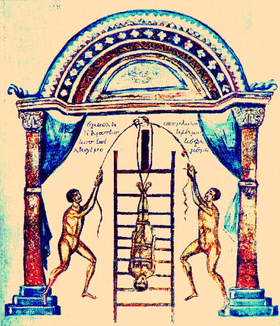Traction (orthopedics)
Traction is a set of mechanisms for straightening broken bones or relieving pressure on the spine[1] and skeletal system. There are two types of traction: skin traction and skeletal traction. They are used in orthopedic medicine.
| Traction (orthopedics) | |
|---|---|
 | |
| ICD-9-CM | 93.4 |
| MeSH | D014143 |
Techniques
Traction procedures have largely been replaced by more modern techniques, but certain approaches are still used today:
- Milwaukee brace
- Bryant's traction
- Buck's traction, involving skin traction. It is widely used for femoral fractures, low back pain, acetabular fractures and hip fractures.[2] Skin traction rarely causes fracture reduction, but reduces pain and maintains the length of the bone.[2]
- Dunlop's traction – humeral fractures in children
- Russell's traction
Skeletal traction
Although the use of traction has decreased over the years, an increasing number of orthopaedic practitioners are using traction in conjunction with bracing (see Milwaukee brace).
Harrison et al. (2005) found that mirror image (opposite posture) postural corrective exercises and a new method of lumbosacral tilt traction resulted in 50% reduction in trunk tilt and were associated with nearly resolved pain intensity in this patient population.[3] These researchers felt that their findings warranted further study in the conservative treatment of chronic low back pain and spinal disorders.
Spinal decompression
Spinal traction as a means of spinal decompression is often applied without directly touching bones as other methods of traction do. This is sometimes isolated inside-out by inflatable girdles or use of the transversus abdominis muscle. It is also done in conjunction with thigh-supported flexed-hip traction (inversion chairs, back hyperextensions) or done in conjunction with whole-leg traction (boots, tables) via inverted forms of suspension.
Traction of the spine (except the cervical) also occurs with upright suspension of the body from the arms, such as with pull-ups, dips, captain's chair, chinnings (chin up exercise) or other fitness movements with the feet dangling.
Purpose
The purpose of traction is to:
- Regain normal length and alignment of involved bone
- Lessen or eliminate muscle spasms
- Relieve pressure on nerves, especially spinal nerves
- Prevent or reduce skeletal deformities or muscle contractures
- To provide a fusiform tamponade around a bleeding vessel
In most cases traction is only one part of the treatment plan of a patient needing such therapy. The physician's order will contain:
- Type of traction
- Amount of weight to be applied
- Frequency of neurovascular checks if more frequent than every four hours
- Site care of inserted pins, wires, or tongs
- The site and care of straps, harnesses and halters
- The inclusion of any other physical restraints / straps or appliances (e.g., mouth guard)
- The discontinuation of traction
References
- Burke, G.L., "Backache from Occiput to Coccyx"
- Skin Traction - Lower Extremity from University of Stellenbosch, Department of Orthopaedic Surgery. Retrieved May 2, 2013
- Harrison DE, Cailliet R, Betz JW, Harrison DD, Colloca CJ, Haas JW, Janik TJ, Holland B (Mar 2005). "A non-randomized clinical control trial of Harrison mirror image methods for correcting trunk list (lateral translations of the thoracic cage) in patients with chronic low back pain". Eur. Spine J. 14 (2): 155–62. doi:10.1007/s00586-004-0796-z. PMC 3476700. PMID 15517424.
External links
| Wikimedia Commons has media related to Orthopedic traction. |
- Byrne T (1999). "The setup and care of a patient in Buck's traction". Orthop Nurs. 18 (2): 79–83. doi:10.1097/00006416-199903000-00011. PMID 10410051.
- "Split Russell's / Buck Traction"
- synd/2984 at Who Named It? - Bryant's traction
- "Physio-pedia about another spinal traction therpay method"